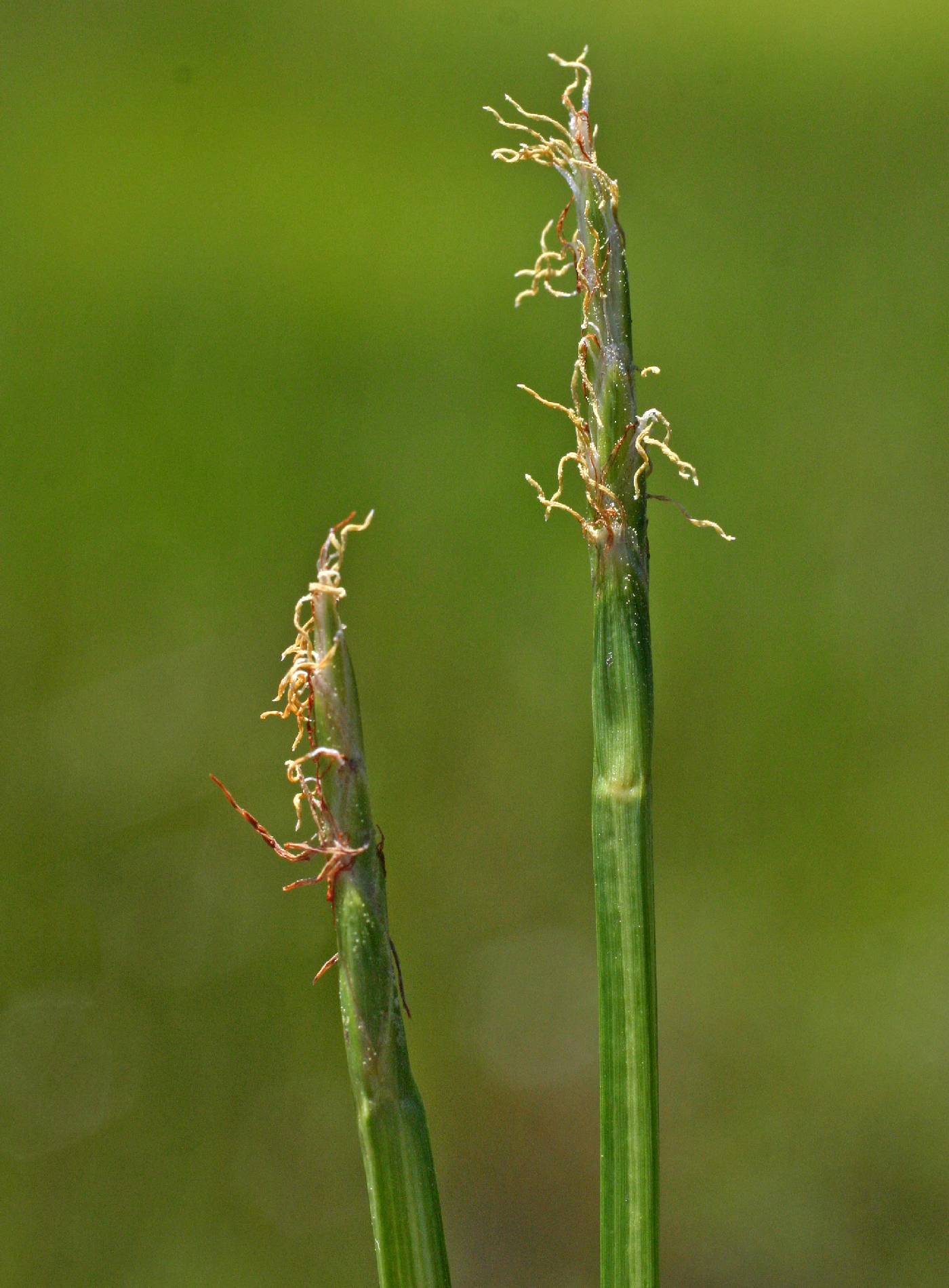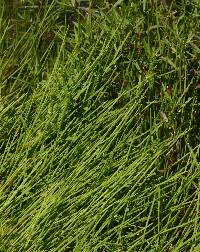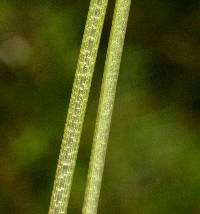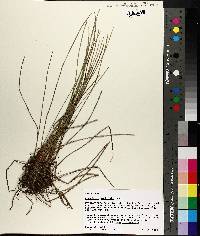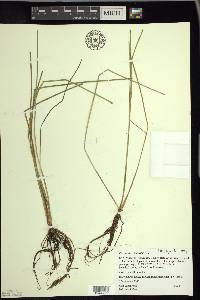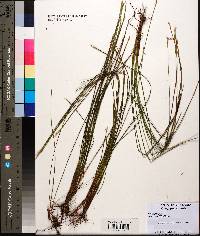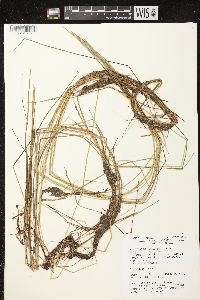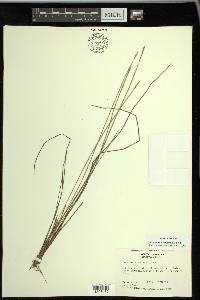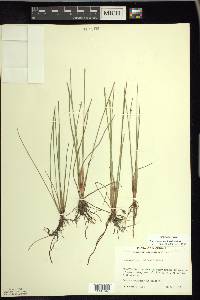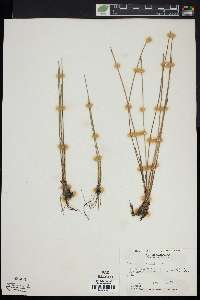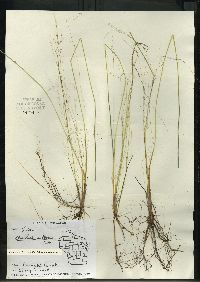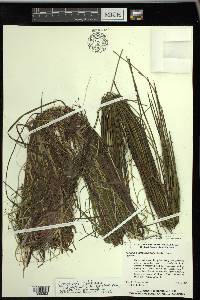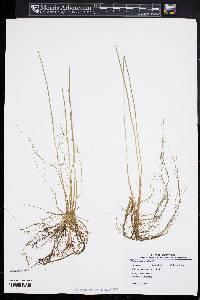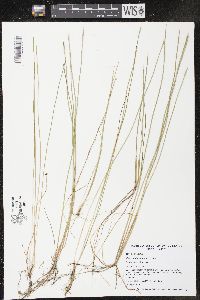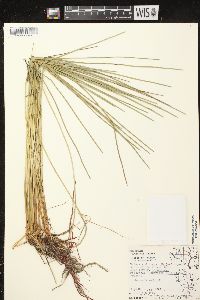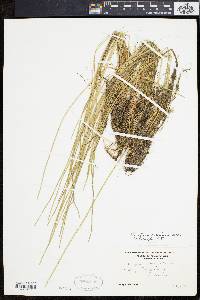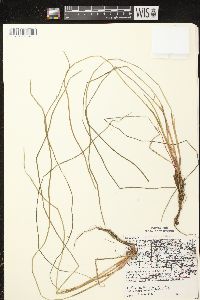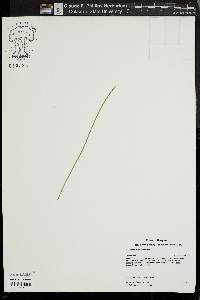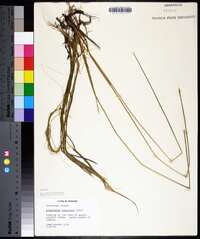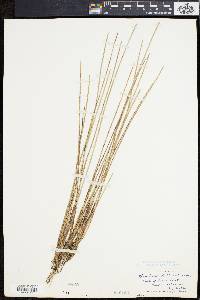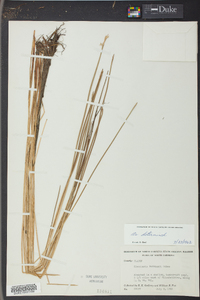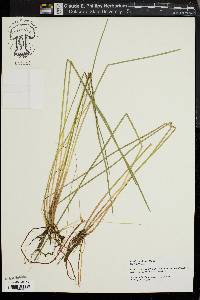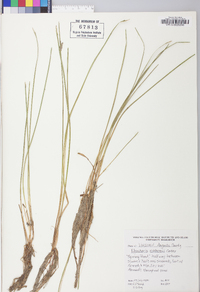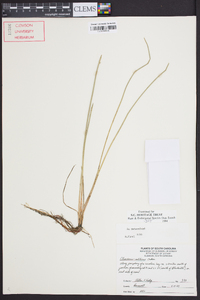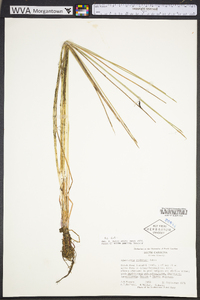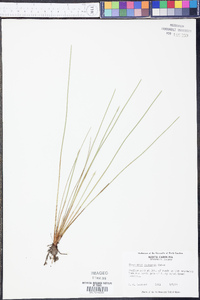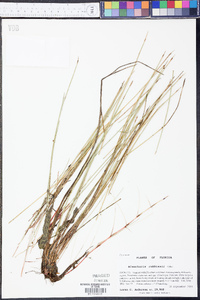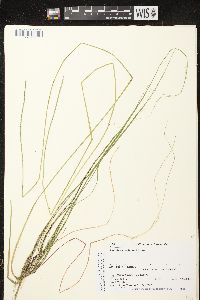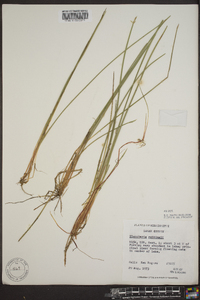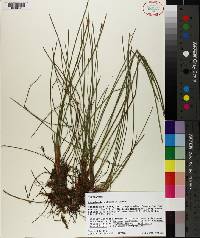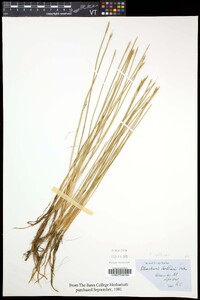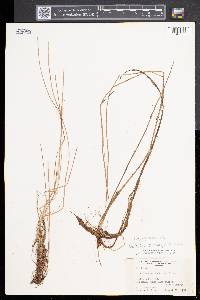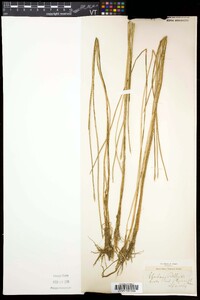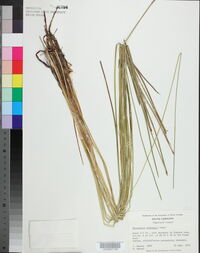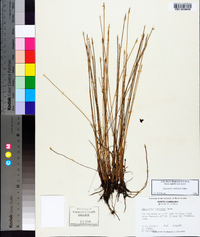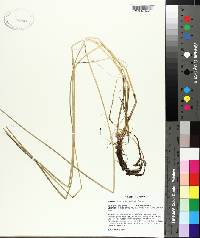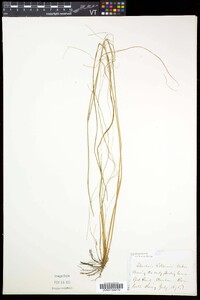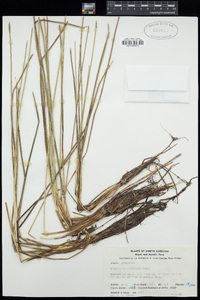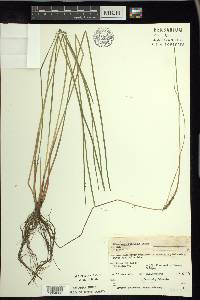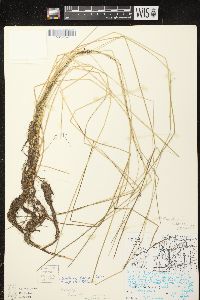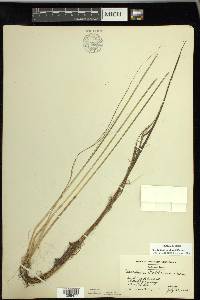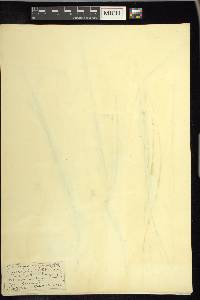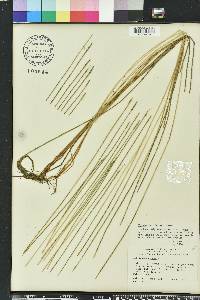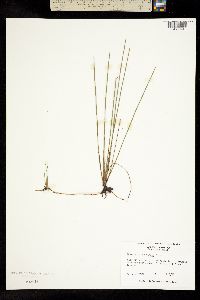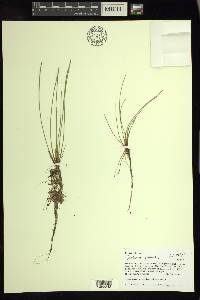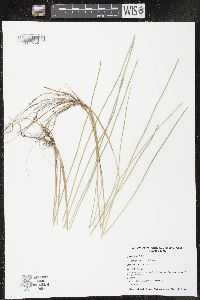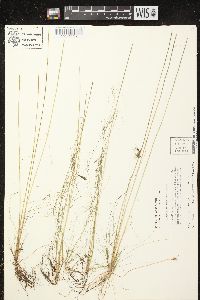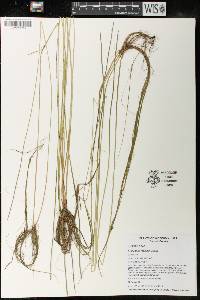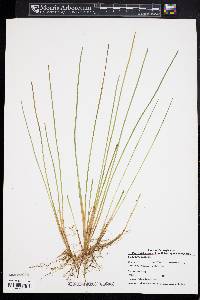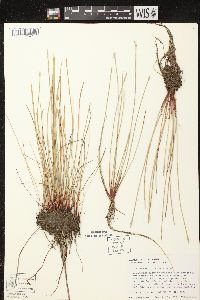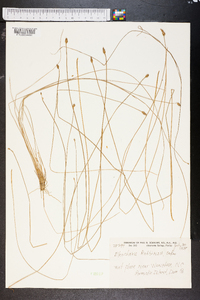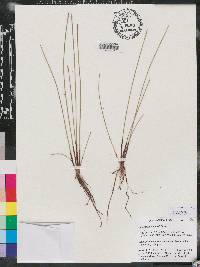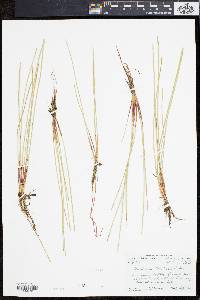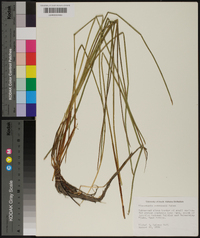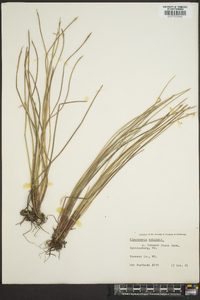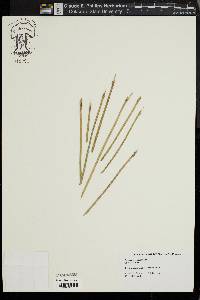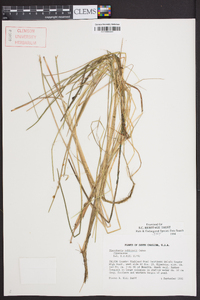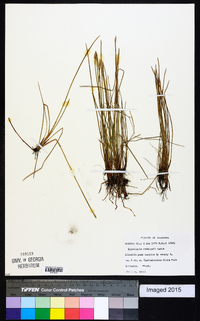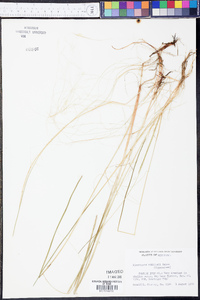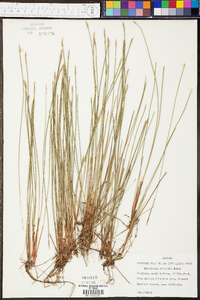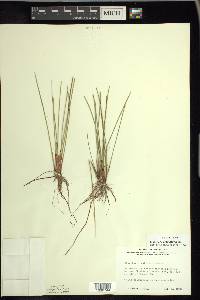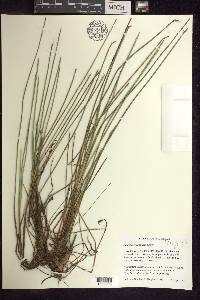
|
|
|
|
Family: Cyperaceae
Robbins' Spike-Rush
|
Plants perennial; rhizomes (0.5-)1-2 mm thick, longer internodes 2-3 cm, scales 5-7 mm; tubers sometimes present, apical, ovoid, 4-8 × 3-4 mm. Culms acutely trigonous; spikelet-bearing culms 16-70 cm × 0.7-0.9 mm; when submersed plants often forming numerous, filiform, flaccid culms without spikelets, sometimes with whorls of slender branches, 0.1-0.3 mm wide; soft, sometimes septate-nodulose when aquatic, internally spongy, transverse septa incomplete. Leaves: distal leaf sheaths persistent or decaying, membranous, apex obtuse to acuminate. Spikelets sometimes proliferous (when submerged), 9-33 × 1.5-3 mm; rachilla joints bearing prominent winglike remnants of floral scales; proximal scale with a flower, amplexicaulous, (5-)6-9.8 mm; floral scales 4-18, 0.5-1 per mm of rachilla, stramineous to pale brown, often minutely dotted reddish, without or rarely with darker submarginal band, narrowly ovate to lanceolate, 5-7.8 × 2-3 mm, thickly papery, membranous toward margins, apex narrowly rounded to acute. Flowers: perianth bristles 6-7, stramineous to reddish brown, proximally slightly flattened, subequal to equal, much exceeding to rarely shorter than achene, 3-5 mm, retrorsely spinulose; anthers yellow to reddish, 1.6-3.2 mm; styles 3-fid. Achenes stramineous or medium brown, biconvex or compressed trigonous, narrowly obpyriform, 1.9-2.6 × 1-1.4 mm, adaxial face with 15-22 rows of rectangular, transversely elongated or nearly isodiametric cells, clearly sculptured at 10-15X, apex usually conspicuously constricted to short neck 0.4-0.7 mm wide, usually wider at tubercle base. Tubercles stramineous to medium brown, high-pyramidal, 0.5-1.1 × 0.3-0.7 mm. Fruiting late spring-late fall. Shallow waters of fresh lakes and ponds with sandy-peaty soils; 10-500 m; N.B., N.S., Ont., Que.; Ala., Conn., Del., Fla., Ga., Maine, Mass., Mich., Minn., N.H., N.J., N.C., Ohio, S.C., Va., Wis. I have not seen voucher specimens for literature reports of Eleocharis robbinsii from Indiana, Pennsylvania, or Rhode Island. Plants from South Carolina with the achene surface cells nearly isodiametric, the achene apex spongy, and the anthers to 3.2 mm may represent an undescribed taxon.
Perennial herb with slender rhizomes, tufted 20 cm - 0.7 m tall Leaves: reduced to bladeless sheaths, basal, two per culm, margins fused and enclosing culm, brownish, with a blunt to pointed apex, membranous. Flowers: minute, spirally arranged on the axis of the spikelet, lacking sepals and petals, with six to seven bristles, subtended by a scale. Bristles straw-colored to reddish brown, 3 - 5 mm long, longer than the achene, slightly flattened basally, toothed. Stamens exserted. Anthers yellowish to reddish, 1.5 - 3 mm long. Pistil one. Style three-cleft. Fruit: a one-seeded achene, straw-colored or brown, 2 - 2.5 mm long, over 1 mm wide, narrowly reverse pear-shaped, biconvex or compressed three-angled, sculpted (at 10-15X), constricted into a short neck at the apex. Tubercle tiny, tall-pyramidal. Seed with a thin, non-adherent wall. Culm: unbranched, 20 cm - 0.7 m long, 1 - 2 mm wide, acutely three-angled, spongy inside, enclosed basally by two fused sheaths. When submersed, the plant often forms numerous thread-like culms which do not bear spikelets. Spikelets: solitary, 9 mm - 3 cm long, 1.5 - 3 mm wide, lance-shaped with a pointed or nearly awl-shaped apex, with four to eighteen floral scales. Scales spirally arranged and overlapping, straw-colored to light brown, often minutely reddish-dotted, 5 - 7.5 mm long (bottom scale 6 - 10 mm long), 2 - 3 mm wide, narrowly egg-shaped to lance-shaped with a narrowly rounded to pointed apex, papery, marginally membranous. Prominent, wing-like remnants of floral scales are found in the joints of the spikelet axis. Similar species: No information at this time. Flowering: late June to mid-August Habitat and ecology: Rare in the eastern sector of the Chicago Region where it is found organic-rich flats and bogs. Occurence in the Chicago region: native Etymology: Eleocharis comes from the Greek words heleios, meaning "dwelling in a marsh," and charis, meaning grace. Robbinsii is named after James Watson Robbins (1801-1879). Author: The Morton Arboretum Cespitose and rhizomatous perennial, in water often producing floating tufts of capillary stems; fertile stems slender, triangular, 2-7 dm, 1-2 mm thick; sheaths brown, obliquely truncate; spikelet lanceolate, 1-2(-2.5) cm נ2-3 mm, acute to almost subulate, 4-8-fld; scales few, lance-ovate, tapering to an obtuse tip, scarious-margined; bristles conspicuously toothed, surpassing the achene; style trifid; achene biconvex, obovoid, brown, 2-2.5 mm, constricted above to an urn-shaped neck, marked with vertical rows of transversely elongate cells; tubercle flattened, acuminate, a quarter to half as long as the achene. In mud or shallow water; along the coast from N.B. and N.S. to Fla., and inland from N.Y. to Ind., Mich., and Wis. Gleason, Henry A. & Cronquist, Arthur J. 1991. Manual of vascular plants of northeastern United States and adjacent Canada. lxxv + 910 pp. ©The New York Botanical Garden. All rights reserved. Used by permission. From Flora of Indiana (1940) by Charles C. Deam In marly soil on the borders of lakes. This species apparently does not fruit every year and it may be more frequent in Indiana than our records indicate. ...... Indiana Coefficient of Conservatism: C = 10 Wetland Indicator Status: OBL |
|
|
|
This project was made possible in part by the Institute of Museum and Library Services [MG-70-19-0057-19].
Powered by Symbiota

